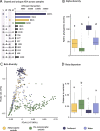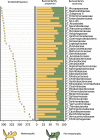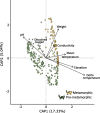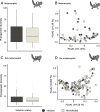The skin microbiota of the axolotl Ambystoma altamirani is highly influenced by metamorphosis and seasonality but not by pathogen infection
- PMID: 36503640
- PMCID: PMC9743558
- DOI: 10.1186/s42523-022-00215-7
The skin microbiota of the axolotl Ambystoma altamirani is highly influenced by metamorphosis and seasonality but not by pathogen infection
Abstract
Background: Microbiomes have been increasingly recognized as major contributors to host health and survival. In amphibians, bacterial members of the skin microbiota protect their hosts by inhibiting the growth of the fungal pathogen Batrachochytrium dendrobatidis (Bd). Even though several studies describe the influence of biotic and abiotic factors over the skin microbiota, it remains unclear how these symbiotic bacterial communities vary across time and development. This is particularly relevant for species that undergo metamorphosis as it has been shown that host physiology and ecology drastically influence diversity of the skin microbiome.
Results: We found that the skin bacterial communities of the axolotl A. altamirani are largely influenced by the metamorphic status of the host and by seasonal variation of abiotic factors such as temperature, pH, dissolved oxygen and conductivity. Despite high Bd prevalence in these samples, the bacterial diversity of the skin microbiota did not differ between infected and non-infected axolotls, although relative abundance of particular bacteria were correlated with Bd infection intensity.
Conclusions: Our work shows that metamorphosis is a crucial process that shapes skin bacterial communities and that axolotls under different developmental stages respond differently to environmental seasonal variations. Moreover, this study greatly contributes to a better understanding of the factors that shape amphibian skin microbiota, especially in a largely underexplored group like axolotls (Mexican Ambystoma species).
Keywords: Amphibians; Metamorphosis; Seasonality; Skin microbiota.
© 2022. The Author(s).
Conflict of interest statement
The authors declare no competing interests.
Figures






Similar articles
-
Host Species and Environment Shape the Skin Microbiota of Mexican Axolotls.Microb Ecol. 2024 Jul 24;87(1):98. doi: 10.1007/s00248-024-02411-1. Microb Ecol. 2024. PMID: 39046491 Free PMC article.
-
Gene functions of the Ambystoma altamirani skin microbiome vary across space and time but potential antifungal genes are widespread and prevalent.Microb Genom. 2024 Jan;10(1):001181. doi: 10.1099/mgen.0.001181. Microb Genom. 2024. PMID: 38240649 Free PMC article.
-
Inhibition of Batrachochytrium dendrobatidis Infection by Skin Bacterial Communities in Wild Amphibian Populations.Microb Ecol. 2021 Oct;82(3):666-676. doi: 10.1007/s00248-021-01706-x. Epub 2021 Feb 18. Microb Ecol. 2021. PMID: 33598748
-
Environmental Factors and Host Microbiomes Shape Host-Pathogen Dynamics.Trends Parasitol. 2020 Jul;36(7):616-633. doi: 10.1016/j.pt.2020.04.010. Epub 2020 May 10. Trends Parasitol. 2020. PMID: 32402837 Review.
-
Research Status and Prospect of Amphibian Symbiotic Microbiota.Animals (Basel). 2025 Mar 25;15(7):934. doi: 10.3390/ani15070934. Animals (Basel). 2025. PMID: 40218328 Free PMC article. Review.
Cited by
-
Environmental and Anthropogenic Factors Shape the Skin Bacterial Communities of a Semi-Arid Amphibian Species.Microb Ecol. 2023 Aug;86(2):1393-1404. doi: 10.1007/s00248-022-02130-5. Epub 2022 Nov 29. Microb Ecol. 2023. PMID: 36445401 Free PMC article.
-
Host Species and Environment Shape the Skin Microbiota of Mexican Axolotls.Microb Ecol. 2024 Jul 24;87(1):98. doi: 10.1007/s00248-024-02411-1. Microb Ecol. 2024. PMID: 39046491 Free PMC article.
-
Differences in composition and potential function of the bacterial communities of cave- and surface-dwelling Mexican salamanders.Anim Microbiome. 2025 Jun 3;7(1):56. doi: 10.1186/s42523-025-00423-x. Anim Microbiome. 2025. PMID: 40462248 Free PMC article.
-
More Than Meets the Eye: Unraveling the Interactions Between Skin Microbiota and Habitat in an Opportunistic Amphibian.Microb Ecol. 2025 Jan 24;87(1):176. doi: 10.1007/s00248-025-02489-1. Microb Ecol. 2025. PMID: 39853499 Free PMC article.
-
Gene functions of the Ambystoma altamirani skin microbiome vary across space and time but potential antifungal genes are widespread and prevalent.Microb Genom. 2024 Jan;10(1):001181. doi: 10.1099/mgen.0.001181. Microb Genom. 2024. PMID: 38240649 Free PMC article.
References
LinkOut - more resources
Full Text Sources
